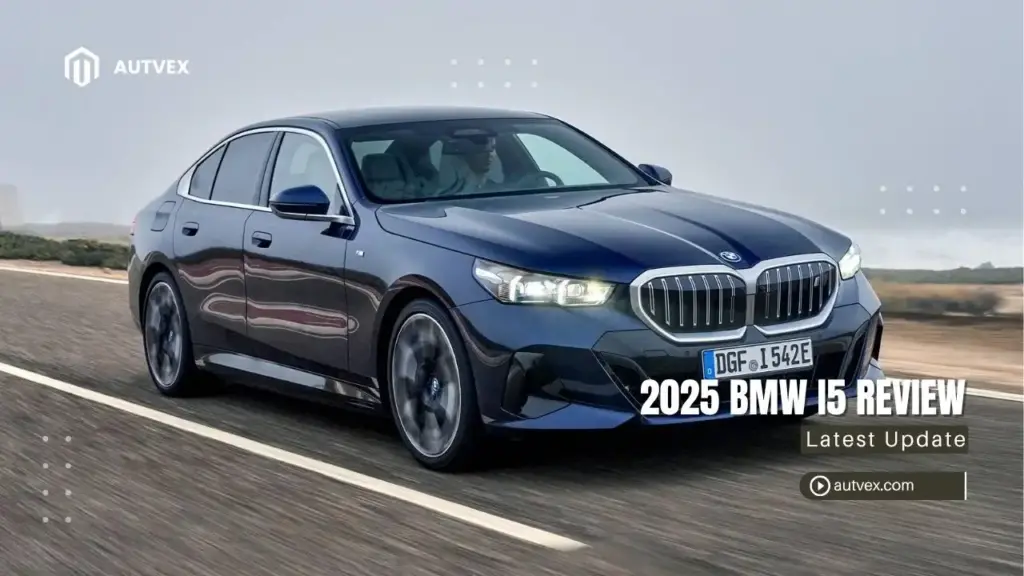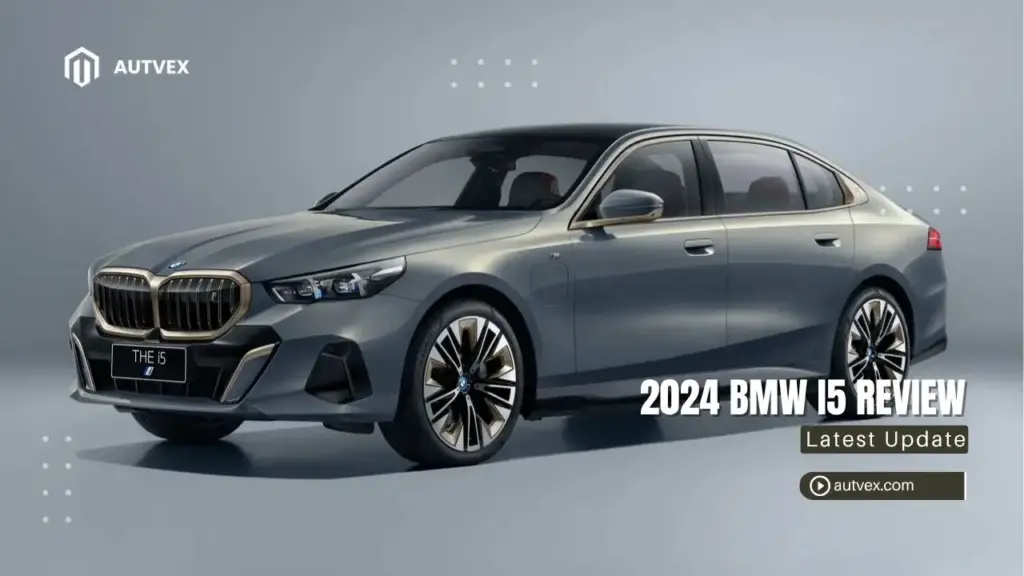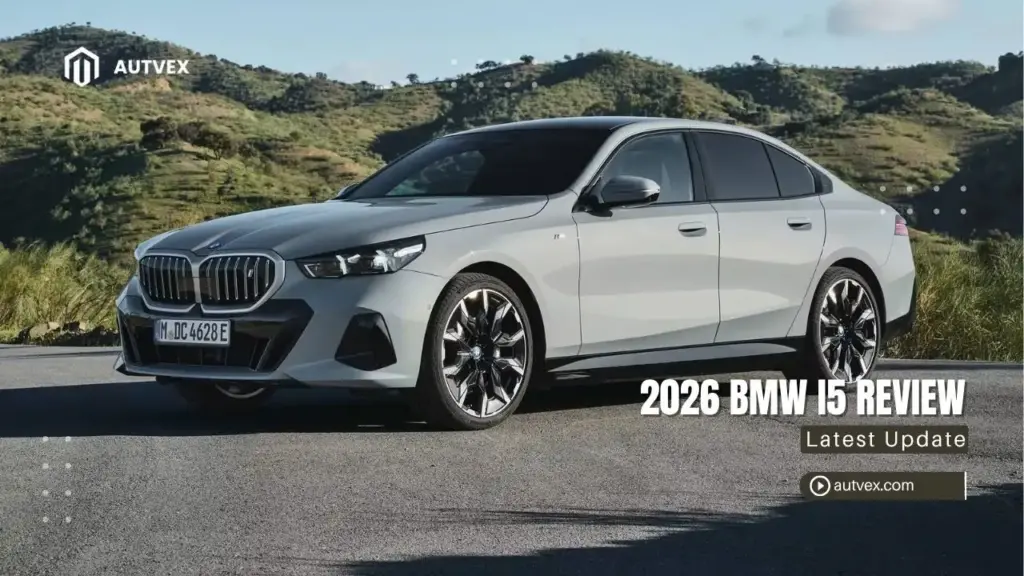You may also like:
The 2025 BMW i5 is a luxury electric sedan that delivers up to 321 miles of real-world range, combining BMW’s renowned driving dynamics with zero-emission technology across three trim levels starting at $67,100. This all-electric version of the iconic 5 Series competes directly with the Mercedes-Benz EQE and Tesla Model S, earning an Editors’ Choice award for its balanced approach to performance, comfort, and technology[1].
For American luxury sedan buyers considering the electric transition, the 2025 i5 represents a compelling option. Edmunds testing achieved an impressive 321 miles on a single charge with the base eDrive40 model—significantly exceeding EPA estimates[2]. According to Autvex automotive experts, the i5 succeeds by prioritizing real-world usability over headline specifications, making it one of the best daily drivers in the luxury EV segment.
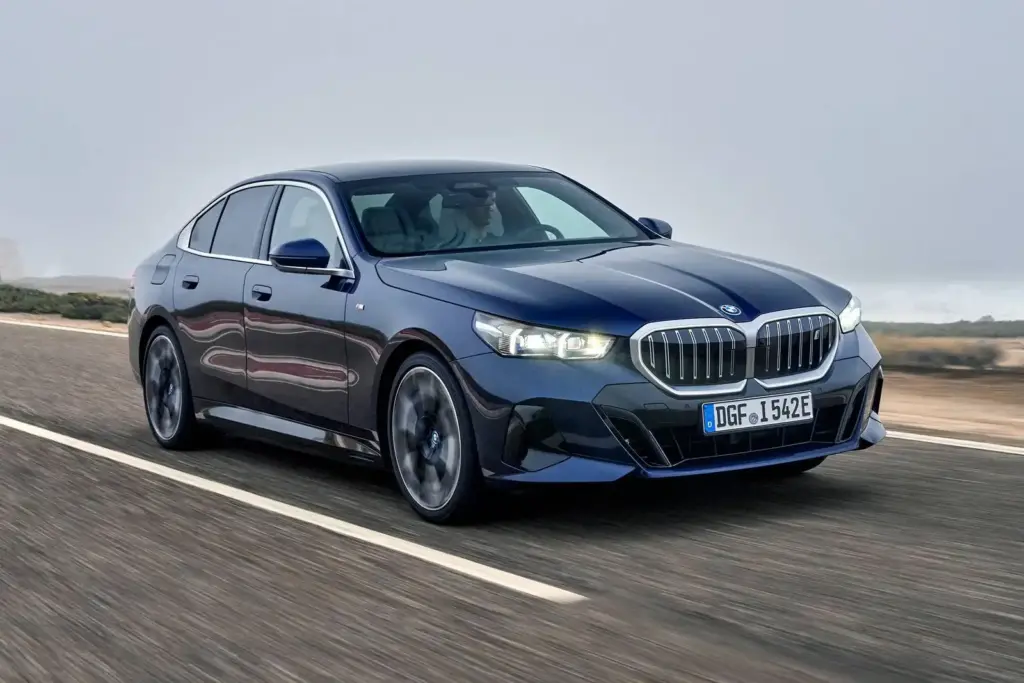
2025 BMW i5 Overview
What’s New for 2025
The 2025 model year brings refinements to the i5 lineup, which launched as an all-new model for 2024. BMW added the xDrive40 mid-tier trim to bridge the gap between the rear-wheel-drive eDrive40 and the performance-focused M60[1]. Pricing remains unchanged from 2024, ranging from $67,100 to $84,100, demonstrating BMW’s commitment to value stability in a volatile EV market.
Key updates for 2025 include:
- New xDrive40 trim: All-wheel-drive option at $70,100
- iDrive 8.5 refinements: Improved interface responsiveness and personalization
- Three trim configurations: eDrive40, xDrive40, and M60 available
- Consistent pricing: No price increases over 2024 model year
- First-generation platform: Part of the inaugural i5 electric sedan lineup
These incremental improvements reflect BMW’s strategy of continuous enhancement rather than dramatic year-over-year changes. Anyone researching how long it takes to buy a car will appreciate that 2025 model availability remains strong through September 2025, when federal EV tax credit eligibility expires[3].
Key Highlights & Market Position
The i5 occupies a unique position as the electric variant of BMW’s legendary 5 Series sedan. Unlike Tesla’s purpose-built EVs or Mercedes’ dedicated EQE platform, the i5 shares its basic architecture with the gas-powered 5 Series, creating visual continuity that appeals to traditional luxury sedan buyers[1].
| Feature | 2025 BMW i5 | Market Context |
|---|---|---|
| Starting Price | $67,100 | $10,800 less than Mercedes EQE ($77,900) |
| Power Range | 335-593 hp | Competitive with segment leaders |
| Real-World Range | 321 miles tested (eDrive40) | Exceeds EPA estimates significantly |
| Efficiency | 104/105 MPGe | Outperforms Mercedes EQE (98/87 MPGe) |
| Display System | BMW Curved Display | Industry-leading 12.3″ + 14.9″ integration |
| Recognition | Editors’ Choice | Award-winning balanced approach |
The i5’s high-tech twin-screen display with BMW Curved Display technology represents one of the most advanced infotainment setups in the automotive industry. Real-world testing consistently shows the i5 exceeding EPA range estimates, with Edmunds achieving 321 miles versus the 270-mile EPA rating—a 19% improvement that matters significantly for daily driving confidence[2].
Who Should Buy the 2025 BMW i5
The ideal i5 buyer values the combination of traditional luxury sedan refinement with modern electric efficiency. BMW enthusiasts making the electric transition will find familiar driving dynamics wrapped in zero-emission technology. The steering weight, chassis balance, and overall driving character maintain BMW’s signature feel despite the shift to battery power[4].
Best suited for:
- Luxury sedan buyers transitioning from gas to electric powertrains
- BMW loyalists seeking traditional driving dynamics in an EV
- Daily commuters with home Level 2 charging access
- Tech-savvy drivers who appreciate advanced infotainment systems
- Buyers prioritizing comfort and refinement over maximum range numbers
Consider alternatives if:
- Maximum range is the top priority (Tesla Model S offers 405 miles EPA)
- Budget constraints are primary concern (Genesis Electrified G80 costs less)
- Maximum cargo space is required (SUVs or Tesla Model S provide more)
- Fastest charging speeds are essential (800V competitors charge quicker)
According to Autvex market analysis, the i5’s sweet spot includes suburban professionals and luxury sedan loyalists who value BMW’s brand prestige, dealer network, and driving experience over the tech-forward approach of newer EV-only brands.
Who Should Consider Alternatives
While the i5 excels in many areas, certain buyer priorities point toward competitors. Maximum range seekers should examine the Tesla Model S, which delivers 405 miles EPA versus the i5’s 295 miles[1]. Budget-conscious shoppers may find better value with the Genesis Electrified G80, which offers similar luxury appointments at a lower price point.
Drivers needing maximum cargo versatility should consider SUV alternatives or the Tesla Model S, which provides a front trunk (frunk) plus generous rear cargo space. Those prioritizing fastest charging speeds should explore 800V architecture competitors like the Porsche Taycan or upcoming Audi A6 e-tron, which achieve 10-80% charging in under 25 minutes versus the i5’s 30-32 minutes[1].
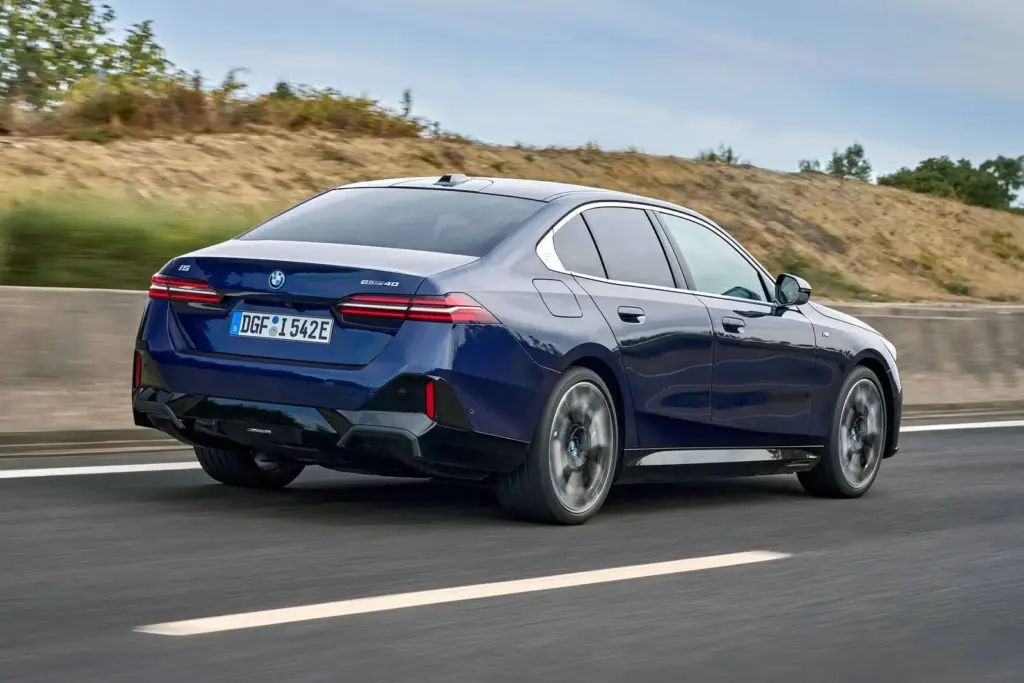
Trim Levels & Pricing
i5 eDrive40 (Base Model)
The rear-wheel-drive eDrive40 starts at $67,100 MSRP and represents the most efficient i5 configuration. The single 335-horsepower rear-mounted electric motor delivers 295 lb-ft of torque, providing what BMW describes as “six-cylinder equivalent” performance[1]. Zero to 60 mph arrives in 5.7 seconds—more than adequate for daily driving and highway merging.
Performance and range specifications:
- EPA range: 270-295 miles depending on wheel size
- Real-world tested: Up to 321 miles on a single charge (Edmunds)
- Efficiency: 104 MPGe city, 105 MPGe highway
- Energy consumption: 28.7 kWh/100 miles (vs 35 kWh EPA estimate)
- Configuration: Single rear motor, rear-wheel drive
The eDrive40 includes impressive standard equipment: heated front seats, dual-zone automatic climate control, panoramic sunroof, Veganza synthetic leather upholstery, BMW Curved Display with iDrive 8.5, wireless Apple CarPlay and Android Auto, Harman Kardon 16-speaker premium audio, and wireless charging pad[1].
i5 xDrive40 (NEW Mid-Tier)
For $70,100, the new-for-2025 xDrive40 adds a front electric motor for all-wheel-drive capability. Combined output reaches 389 horsepower and 435 lb-ft of torque, dropping the 0-60 mph time to 5.2 seconds. The dual-motor setup provides superior traction in adverse weather conditions—a meaningful consideration for buyers in northern states experiencing snow and ice[1].
The additional motor weight and power consumption reduce range to 248-287 miles depending on wheel configuration. For the $3,000 premium over the eDrive40, buyers gain all-weather confidence and noticeably improved acceleration, particularly when merging onto highways or passing slower traffic.
Real-world owner feedback suggests the xDrive40 typically achieves 240-250 miles in mixed driving conditions, making it suitable for daily commuting but requiring more frequent charging on longer trips[5].
i5 M60 xDrive (Performance)
At $84,100, the M60 xDrive positions itself as BMW’s performance electric sedan. With 593 horsepower and 605 lb-ft of torque in Boost Mode, it rockets to 60 mph in just 3.7 seconds according to BMW—though Car and Driver testing achieved an even quicker 3.3 seconds[6].
M60-exclusive features:
- Adaptive M suspension with sport-tuned dampers
- Bowers & Wilkins 17-speaker Diamond Surround Sound system
- M Sport exterior styling with aerodynamic enhancements
- 20-inch M alloy wheels (21-inch optional)
- Enhanced braking system with red M Sport calipers
- Four-zone automatic climate control
- Sky Lounge Panoramic Roof with LED lighting
- Exclusive M interior trim details
The performance premium comes with reduced range—239-253 miles EPA estimated. However, Edmunds testing achieved 264 miles with the M60 equipped with 21-inch wheels, beating the 240-mile EPA estimate by 10%[7]. This consistent pattern of exceeding EPA ratings demonstrates BMW’s conservative range estimates.
Value Analysis & Cost Comparison
BMW held pricing steady for 2025 despite the addition of the xDrive40 trim. The eDrive40’s $67,100 starting price remains competitive against premium electric sedan alternatives, particularly the Mercedes-Benz EQE, which starts at $77,900 with less power (288 hp vs 335 hp)[1].
| Model | Starting Price | Horsepower | EPA Range | Efficiency |
|---|---|---|---|---|
| BMW i5 eDrive40 | $67,100 | 335 hp | 270-295 miles | 104/105 MPGe |
| BMW i5 xDrive40 | $70,100 | 389 hp | 248-287 miles | Similar to eDrive40 |
| BMW i5 M60 | $84,100 | 593 hp | 239-253 miles | Lower due to performance |
| Mercedes EQE 350+ | $77,900 | 288 hp | 260 miles | 98/87 MPGe |
| Tesla Model S | $76,380 | 670 hp | 405 miles | 127/116 MPGe |
Important note about federal tax credits: The 2025 BMW i5 is not eligible for the $7,500 federal EV tax credit for purchases. However, the credit expires entirely on September 30, 2025, after which point no new EVs will qualify[3]. For lease customers, BMW Financial Services applies up to $9,900 in credits as capitalized cost reductions, effectively passing the benefit to lessees[8].
Cost of ownership considerations favor the i5 compared to gas-powered luxury sedans. With no oil changes, transmission services, or complex engine maintenance, annual service costs typically range from $600-$800 versus $1,500-$2,000 for comparable gas models[1].
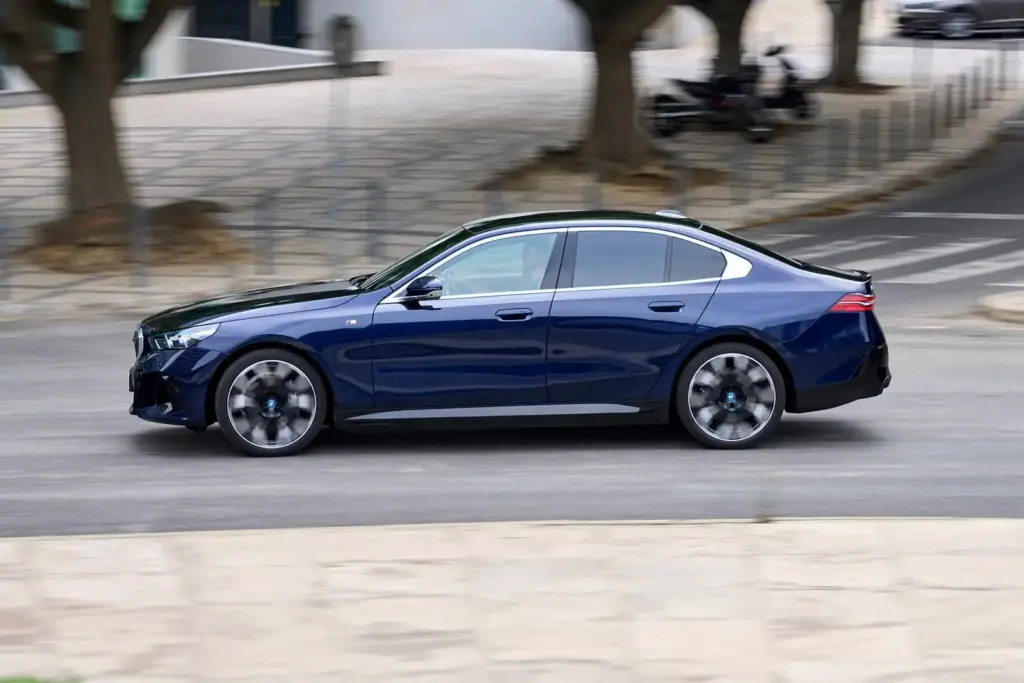
Performance & Powertrain
Electric Motor Technology
The 2025 i5 utilizes BMW’s 5th-generation eDrive electric motor system, representing years of refinement in electric propulsion technology. The system delivers instant torque across the entire speed range without the lag associated with turbocharged internal combustion engines[1].
The eDrive40’s single rear motor provides balanced rear-wheel-drive dynamics that BMW enthusiasts appreciate. The xDrive40 and M60’s dual-motor setups offer all-wheel traction with torque vectoring capability, distributing power between axles for optimal traction and handling. All models utilize a single-speed automatic transmission, providing seamless acceleration without gear changes.
Performance comparison across trims:
- eDrive40: 5.7 seconds (0-60 mph), rear-drive balance, maximum efficiency
- xDrive40: 5.2 seconds (0-60 mph), all-weather capability, moderate efficiency
- M60: 3.3-3.7 seconds (0-60 mph), sports car acceleration, performance focus
The electric powertrain operates with remarkable quiet and smoothness. Without engine noise, wind and tire noise become more noticeable, though BMW’s acoustic engineering keeps the cabin remarkably serene even at highway speeds[4].
Battery & Range Details
All 2025 i5 models utilize an 84.4 kWh battery pack (81.2 kWh usable capacity). BMW’s battery management system optimizes longevity by limiting charging to approximately 96% of total capacity, preserving battery health over the vehicle’s lifetime[1].
Real-world range performance consistently exceeds EPA estimates:
Independent Edmunds testing achieved 321 miles on a single charge with the eDrive40—a remarkable 19% improvement over the 270-mile EPA rating[2]. The M60 with performance-oriented 21-inch wheels traveled 264 miles versus its 240-mile EPA estimate, demonstrating BMW’s conservative rating approach[7].
| Trim | EPA Range | Edmunds Tested | Typical Real-World |
|---|---|---|---|
| eDrive40 (19″ wheels) | 270-295 miles | 321 miles | 280-310 miles |
| xDrive40 | 248-287 miles | Not yet tested | 240-260 miles |
| M60 (21″ wheels) | 239-253 miles | 264 miles | 240-256 miles |
EPA efficiency ratings of 104 MPGe city and 105 MPGe highway position the i5 among the most efficient luxury sedans, significantly outperforming the Mercedes EQE SUV (98/87 MPGe) and crushing the older Audi Q8 e-tron (78/79 MPGe)[1].
Winter range testing shows the i5 maintains approximately 75-80% of rated range in cold weather (32-40°F), dropping to 60-65% in extreme cold (-20°C to -15°C). This represents better cold-weather performance than many competitors[9].
Driving Dynamics & Handling
BMW’s electric sedan retains the brand’s characteristic handling balance despite weighing approximately 4,900-5,200 pounds depending on configuration. The low-mounted battery pack lowers the center of gravity compared to gas-powered 5 Series models, reducing body roll in corners and enhancing stability[4].
The i5 provides a comfortable and composed ride quality that feels faultless for daily driving. Quick acceleration combines with precise steering to deliver satisfyingly quick performance without sacrificing comfort. One-pedal driving mode is available, allowing drivers to modulate speed using primarily the accelerator pedal through regenerative braking.
However, the heavy vehicle weight—inherent to all EVs—does affect ultimate driving dynamics compared to lighter sports sedans. The M60 provides the most engaging driving experience with its adaptive M suspension, though even base models demonstrate composed handling that exceeds most electric sedan competitors[4].
Charging Capabilities
The 2025 i5 supports both AC Level 2 home charging and DC fast charging for on-the-go replenishment. The charging specifications balance practical convenience with reasonable speed[1]:
- AC Level 2 charging: Up to 7.4 kW (standard on all models)
- DC fast charging: Up to 205 kW peak charging rate (400V architecture)
- 10-80% charge time: Approximately 30-32 minutes at peak speeds
- Range addition: 90-100 miles in 10 minutes at DC fast chargers
- Full home charge: Under 9 hours with Level 2 charging
Note that achieving the advertised 30-minute charging time requires 200+ kW DC fast chargers. Lower-power 150 kW stations will take proportionally longer. The i5’s 400V electrical architecture charges slower than competitors using 800V systems—the Audi A6 e-tron achieves 270 kW peak charging for 10-80% in just 21 minutes[1].
BMW includes two years of complimentary Electrify America DC fast-charging, covering 30-minute sessions at the nation’s most extensive CCS charging network. This benefit represents $1,500-$2,000 in value for moderate users and significantly reduces early ownership charging costs[1].
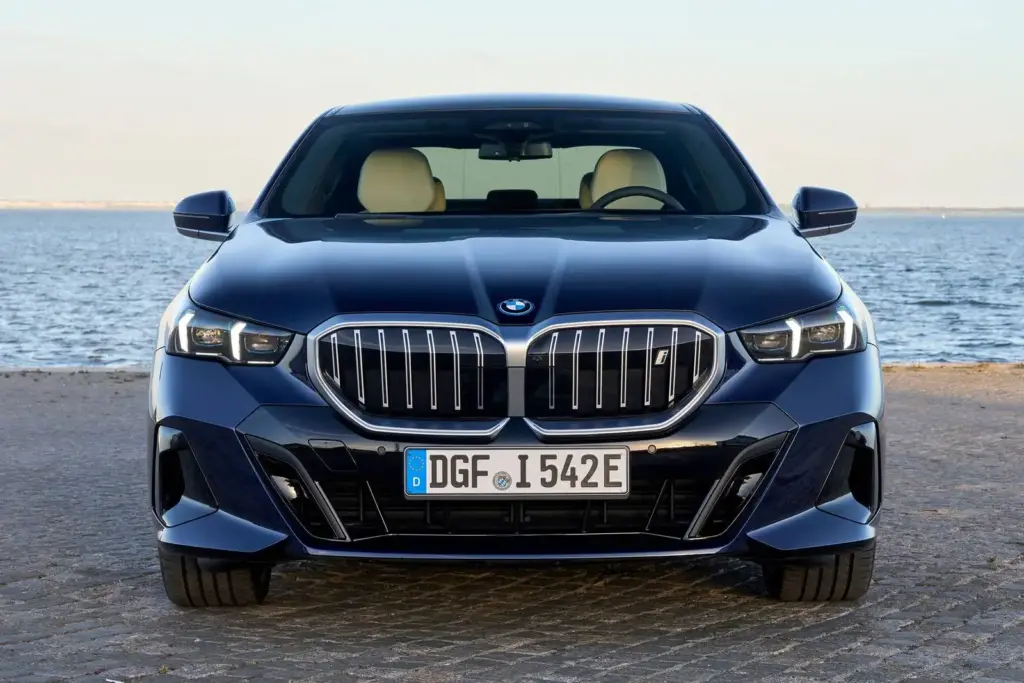
Exterior Design & Style
Signature BMW Styling Elements
The 2025 i5 maintains traditional BMW sedan proportions, sharing its basic design with the gas-powered 5 Series. This conservative styling approach contrasts with more radical EV competitors but appeals to luxury sedan buyers who value familiar aesthetics[1].
BMW’s iconic kidney grille receives special treatment on the i5, with optional Iconic Glow illumination that outlines the grille edges in white light when the vehicle is unlocked or in motion. While some question the necessity of a grille on an electric vehicle, the design maintains visual continuity with BMW’s broader lineup.
The sleek, aerodynamic sedan silhouette achieves an impressive 0.23 drag coefficient—rivaling the egg-shaped Mercedes EQE’s 0.22 while maintaining sharper, more attractive styling. Long hood, short overhangs, and muscular proportions create the classic premium sedan look American buyers expect[1].
Lighting & Visual Features
Laser-cut adaptive LED headlights come standard with self-leveling and automatic high beam functionality. Higher trims add cornering lights that illuminate the road ahead during turns. The M60 features M Sport exterior design elements including aerodynamic enhancements, extended Shadowline trim, and an optional rear lip spoiler for subtle performance cues[1].
Flush door handles improve aerodynamics while adding modern visual appeal. The handles automatically present themselves when the key fob is detected, retracting flush with the body when driving to minimize drag.
Wheels & Tire Options
Wheel selection directly impacts range performance. Each inch increase in wheel diameter reduces EPA estimates by approximately 10-15 miles:
- 19-inch wheels: Standard on eDrive40, optimal for maximum range (295 miles EPA)
- 20-inch wheels: Optional on all trims, moderate range penalty (-10 miles)
- 21-inch wheels: Available on all models, sportiest appearance (-17 miles range)
- M Aero wheels: Exclusive 19-20 inch designs for M60 trim
Buyers prioritizing maximum range should stick with 19-inch wheels unless visual preferences strongly favor larger diameter options. The difference between 19-inch and 21-inch wheels equals approximately 17 miles of range—meaningful for daily driving confidence[1].
Available Exterior Colors
The 2025 color palette spans conservative to bold choices. Alpine White and Carbon Black Metallic remain popular no-cost options, while metallic and specialty colors command $650-$3,300 premiums[1].
- Standard colors: Alpine White (no charge), Carbon Black Metallic
- Metallic finishes ($650-$1,000): Mineral White Metallic, Black Sapphire Metallic, Phytonic Blue Metallic, Tanzanite Blue Metallic, Oxide Grey Metallic, Dark Graphite Metallic
- Premium colors ($1,500-$3,300): Fire Red, Cape York Green, Sophisto Grey
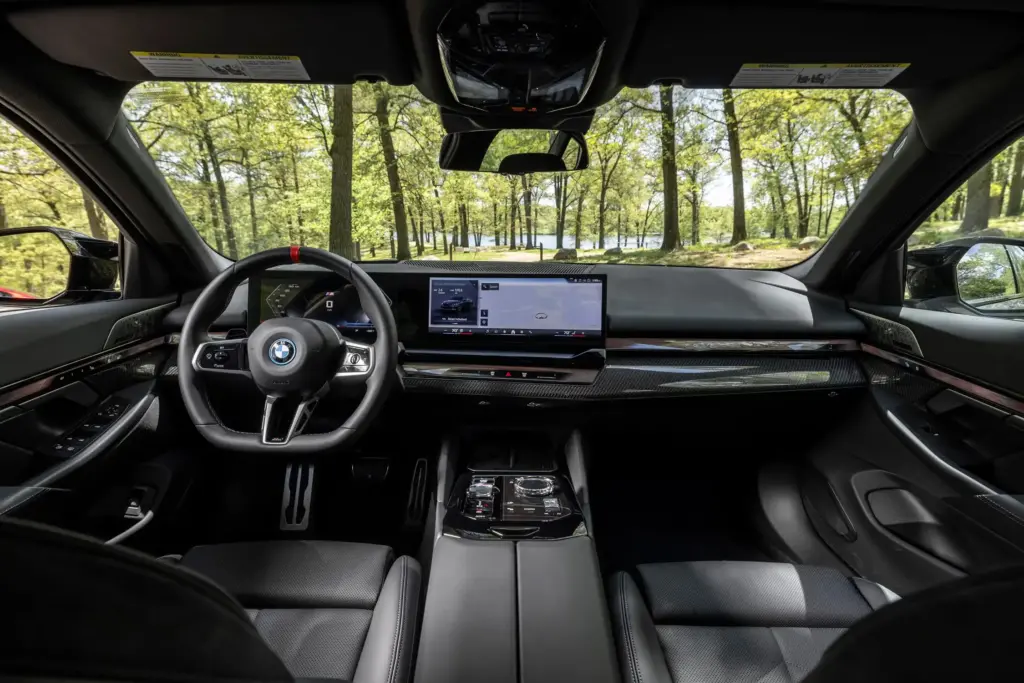
Interior Design & Comfort
Cabin Materials & Build Quality
The 2025 i5 features a spacious, high-tech cabin with luxurious premium finish. BMW equips all models with Veganza synthetic leather upholstery as standard—a vegan material that mimics traditional leather’s appearance and texture while appealing to environmentally conscious buyers[1].
Those preferring genuine leather can upgrade to Extended Merino Leather for $2,450, which covers more interior surfaces and offers softer hand feel with enhanced coverage across door panels and dashboard elements. The fit and finish throughout the cabin meets luxury segment expectations, with tight panel gaps and quality materials extending to lower surfaces.
Ample soft-touch surfaces create a classy and comfortable ambiance. The dashboard incorporates sustainable materials without compromising luxury or comfort, featuring high-quality finishes that compare favorably with competitors like the BMW 5 Series gas sedan[1].
Seating Capacity & Space
The i5 accommodates five passengers with generous front and rear legroom. The cabin benefits from spacious front seating with power adjustment and adequate headroom for tall passengers up to 6’4″. Wide-opening doors facilitate easy entry and exit, particularly helpful when installing child seats or assisting elderly passengers[1].
However, a large central transmission tunnel—carried over from the gas 5 Series architecture—compromises middle rear seat comfort. This design element limits the i5’s advantage over dedicated EV platforms like the Mercedes EQE, which features a flat floor throughout. The 40/20/40 split fold-down rear seats add cargo flexibility for longer items.
Interior Color Schemes
BMW expanded interior color options for 2025, including a new Dark Violet/Atlas Grey Merino leather combination that provides distinctive character[1]:
Standard Veganza options: Black, Smoke White, Burgundy Red, Espresso Brown
Merino leather options (+$2,450): Copper Brown/Atlas Grey, Silverstone II Atlas Grey, Dark Violet/Atlas Grey (NEW), Black/Atlas Grey Extended Merino Leather
The new Dark Violet combination appeals to buyers wanting individuality without sacrificing sophistication, pairing rich purple tones with neutral grey accents throughout the cabin.
Comfort & Convenience Features
Standard comfort features include 3-stage heated front seats, dual-zone automatic climate control, power-operated panoramic glass sunroof, and power-adjustable front sport seats. Optional heated and ventilated front seats with massage functions ($1,500-$2,000 depending on package) elevate comfort significantly on long drives[1].
The massage function offers multiple programs targeting different muscle groups—a genuine benefit rather than a gimmick. Heated rear seats are available bundled with other premium options. The M60 includes four-zone automatic climate control as standard, allowing rear passengers independent temperature control.
The optional Sky Lounge Panoramic Roof features LED ambient lighting patterns integrated into the glass, creating a unique nighttime ambiance that enhances the premium feel.
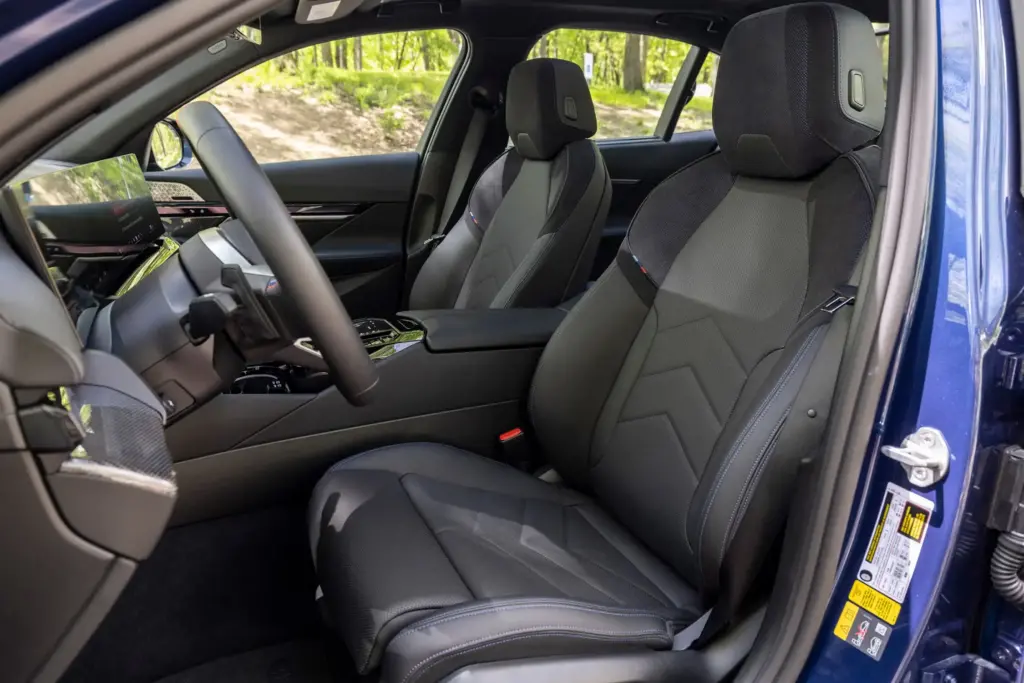
Technology & Infotainment
BMW Curved Display System
The i5’s technology centerpiece features a seamless curved glass panel housing a 12.3-inch digital instrument cluster with a 14.9-inch central touchscreen. This high-tech twin-screen display integration creates visual continuity while keeping critical driving information directly in the driver’s sightline[1].
The configurable displays offer multiple layout options emphasizing navigation, audio, performance data, or EV-specific information like energy flow and charging status. High-resolution graphics render clearly even in direct sunlight, and the anti-glare coating minimizes reflections. This minimalist, futuristic dashboard look distinguishes the i5 from more conservative competitors.
iDrive 8.5 Operating System
BMW’s latest iDrive 8.5 system provides multiple interaction methods—touchscreen, voice commands, hand gesture recognition, and the traditional iDrive controller wheel. This redundancy means drivers can choose their preferred input method rather than being forced into a single interface style[1].
QuickSelect shortcuts provide one-touch access to climate, audio, and navigation functions without diving through menus. The generally intuitive interface works well once personalized, though the main menu layout can be overwhelming initially and requires customization for optimal usability.
EV-specific features include:
- Real-time range prediction accounting for traffic, weather, and driving style
- Charging station integration with live availability data
- Intelligent route planning that adds charging stops automatically
- Pre-conditioning controls to optimize battery temperature before charging
- Remote software upgrades via over-the-air updates
The voice assistant responds to natural language commands rather than requiring specific phrases. Saying “I’m cold” automatically increases cabin temperature, while “Find me a fast charger” routes to the nearest DC fast-charging station with real-time availability[1].
Connectivity & Smartphone Integration
Wireless Apple CarPlay and Android Auto come standard, connecting automatically when the driver’s phone is in the vehicle. The wireless charging pad accommodates even the largest smartphones. Multiple USB-C ports (front and rear) ensure all passengers can keep devices charged[1].
The on-board Wi-Fi hotspot supports up to 10 connected devices, using either the vehicle’s embedded data connection or tethering to the driver’s phone. BMW Remote Services enable owners to check charging status, pre-condition the cabin, lock/unlock doors, and locate the vehicle through the My BMW smartphone app.
Audio & Entertainment
The 2025 i5 includes the Harman Kardon premium 16-speaker audio system as standard equipment, delivering excellent sound quality with clear highs, warm mids, and surprising bass depth. M60 models upgrade to the Bowers & Wilkins 17-speaker Diamond Surround Sound system with diamond dome tweeters and dedicated amplifier[1].
The Bowers & Wilkins system represents BMW’s top audio option, delivering concert hall-like sound staging and detail resolution. Audiophiles will appreciate the difference, though casual listeners may find the Harman Kardon system entirely satisfactory. Multiple sound profiles allow users to tailor audio characteristics to personal preferences or music genres.
Optional Tech Upgrades
Beyond standard equipment, BMW offers several technology enhancements worth considering:
- BMW Iconic Glow ($500): Illuminated kidney grille outlines that activate when unlocking
- Head-up display with augmented reality ($1,900): Projects navigation arrows onto road ahead
- Sky Lounge Panoramic Roof ($2,500): Includes LED ambient lighting patterns in glass
- Digital Cockpit Professional: Enhanced graphics and additional display configurations
- Advanced parking assistance: Includes automated parking and surround-view monitoring
The augmented reality head-up display represents the most valuable optional technology, overlaying turn-by-turn directions directly in the driver’s view. This system genuinely improves usability compared to traditional head-up displays that show abstract arrow graphics[1].
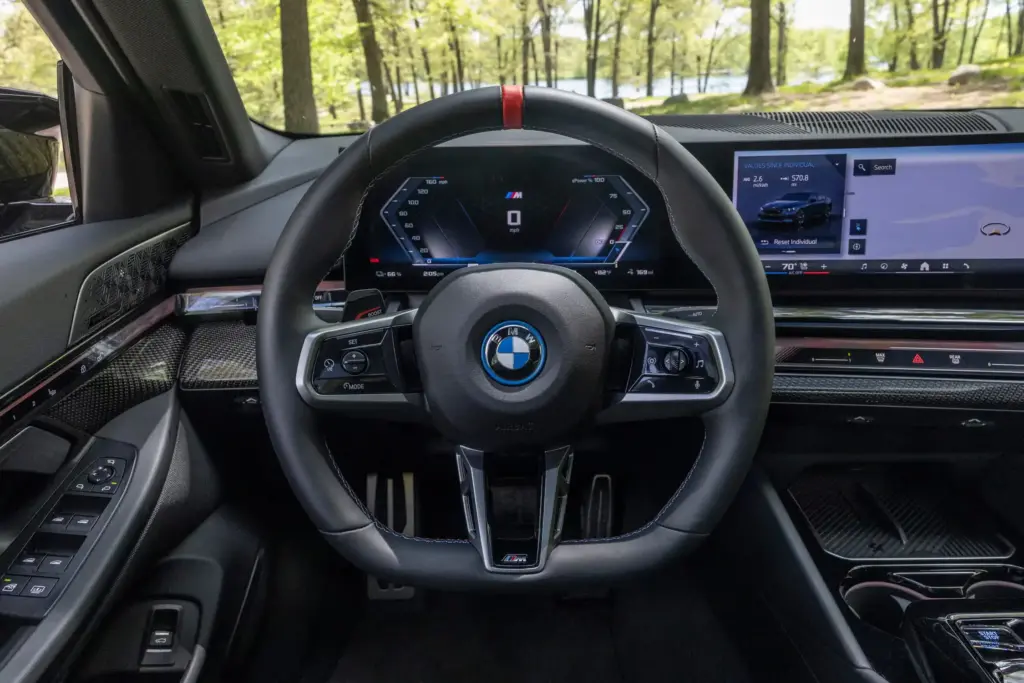
Safety & Driver Assistance
Standard Safety Features
BMW equips all 2025 i5 models with comprehensive active safety systems at no additional cost. These include forward collision warning with automatic emergency braking, active blind spot detection (standard on all trims), lane departure warning and lane-keeping assist, rear cross-traffic warning, and adaptive cruise control with stop-and-go functionality[10].
Additional standard features include driver attention monitoring that analyzes steering patterns for drowsiness, rain-sensing windshield wipers, and parking sensors front and rear. These systems work unobtrusively in the background, intervening only when necessary while allowing confident drivers to maintain control.
IIHS Safety Ratings & Crash Test Results
The 2025 BMW i5 received strong ratings from IIHS testing, earning a “Good” rating for front crash prevention with pedestrian detection. The i5 successfully avoided collisions in 12 mph and 25 mph crossing child tests, demonstrating effective pedestrian protection[10].
Night pedestrian test performance showed the i5 avoided collisions at 12, 25, and 37 mph with both high and low beams—indicating excellent headlight effectiveness and automatic emergency braking response. Standard blind spot detection and lane departure warning systems provide comprehensive monitoring of surrounding traffic.
Advanced Driver Assistance (Optional)
The Driving Assistance Professional Package ($2,500) adds BMW’s most advanced semi-autonomous capabilities. BMW Highway Assistant enables hands-free highway driving at speeds up to 85 mph when lane markings are clear, though the system requires drivers to maintain attention by monitoring eye position[1].
Active Lane Change Assist can execute lane changes with driver approval via turn signal activation—a feature available in select markets. Parking Assistant Professional with automated parking can identify suitable parking spaces and steer the vehicle into them while the driver controls throttle and brake.
The 360-degree camera system provides bird’s-eye view perspective for tight parking situations. Traffic jam assistant combines lane keeping and adaptive cruise to handle bumper-to-bumper situations below 37 mph autonomously, significantly reducing driver fatigue during congested commutes.
Note: Radar cruise control is surprisingly missing from lower trim levels—a premium feature omission that some reviewers criticize given the i5’s luxury positioning[1].
Airbag & Structural Safety
The i5’s safety structure incorporates multiple airbags throughout the cabin, electronic stability control, traction control, and high-strength chassis construction. The battery pack mounting structure serves dual purposes—protecting the battery from intrusion while contributing to overall chassis rigidity. This design approach typifies modern EV safety philosophy, turning potential vulnerabilities into structural advantages. A tire pressure monitoring system with individual wheel readouts alerts drivers to pressure changes before they become safety issues[1].
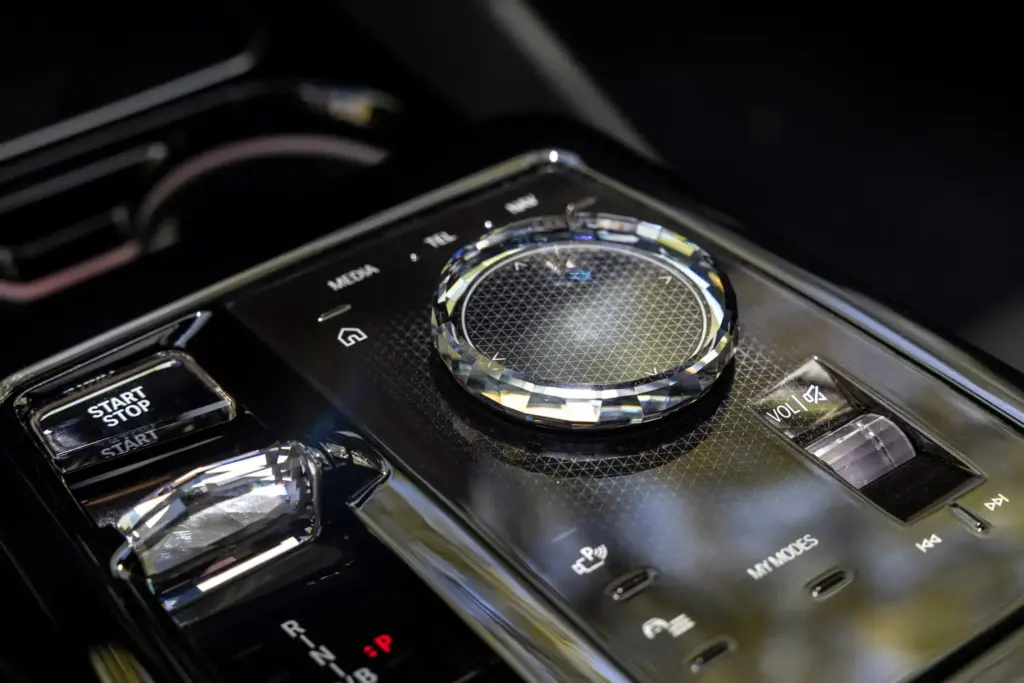
Cargo & Storage
Trunk Space Specifications
The 2025 i5 provides approximately 17-18 cubic feet of cargo capacity—less than the gas-powered 5 Series sedan due to battery placement. The battery pack under the rear seats encroaches on cargo volume, a common compromise in electric vehicles adapted from internal combustion platforms[1].
Compared to competitors, the i5 offers 490 liters of trunk space versus the Mercedes EQE’s 430 liters, though both trail the Tesla Model S significantly. The Tesla provides 709 liters in the rear trunk plus an 89-liter front trunk (frunk) for total cargo capacity that dwarfs the i5[1].
Pass-through 40/20/40 split fold-down rear seats allow longer items like skis to fit, though the opening is somewhat narrow. The wide trunk opening simplifies loading and unloading heavy items. Underfloor storage compartments house the portable charging cable and provide secure storage for valuables.
Interior Storage Solutions
Interior storage includes a center console bin sized for two smartphones, though the wireless charging pad occupies one position. Door pockets are average-sized, accommodating standard water bottles but not oversized thermoses. Cupholders in the center console position drinks conveniently for both driver and passenger[1].
A sunglass holder overhead provides padded storage for eyewear, while rear seat storage pockets hold magazines or tablets. The lack of a front trunk (frunk) disappoints compared to Tesla or dedicated EV platforms—the front space houses electronic components rather than providing additional luggage room.
Practicality Considerations
The i5’s cargo limitations versus competitors like Tesla become apparent on family road trips or airport runs. Tesla’s clear advantage in total cargo space (frunk plus trunk) provides more flexibility for luggage, sports equipment, or grocery shopping. However, for daily driving and typical luxury sedan use cases, the i5’s 17-18 cubic feet proves adequate[1].
Child seat compatibility is excellent thanks to easy-access LATCH anchor points between the rear seat cushion and backrest. The spacious rear seat accommodates larger convertible child seats comfortably, and the wide-opening doors simplify installation of rear-facing seats.
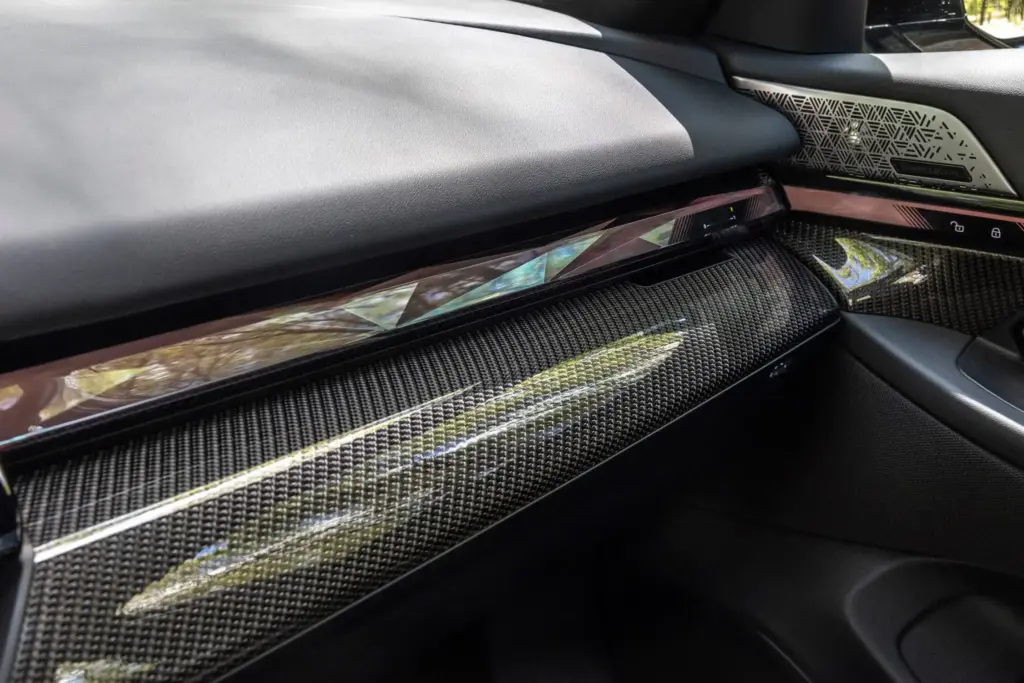
Ownership Experience & Real-World Use
Daily Driver Suitability
The 2025 BMW i5 excels as a daily driver, feeling faultless for typical commuting and errand running. Quiet and comfortable operation makes it well-suited for both city traffic and highway cruising. The instant electric torque provides effortless acceleration for merging and passing, while the smooth, composed ride quality enhances comfort over long distances[4].
Real-world owner experiences consistently praise the i5’s suitability for daily driving. One owner reported covering their entire family holiday without recharging despite making full use of climate control and never driving with efficiency in mind[9]. The range suitable for daily use, though not exceptional compared to Tesla, proves more than adequate for typical American driving patterns.
Long road trip capability is strong thanks to the i5’s real-world range exceeding EPA estimates. The accurate range readout helps prevent range anxiety—if anything it errs on the side of caution, often showing estimated remaining range increasing as you drive along[9].
Charging & Range in Real-World Conditions
Home Level 2 charging installation typically costs $500-$2,000 depending on existing electrical capacity and distance from the main panel. Most i5 owners install 40-50 amp circuits supporting the vehicle’s 7.4 kW onboard charger, enabling full overnight charging in under 9 hours[1].
Public charging network experiences with Electrify America prove generally positive. The included two years of free DC fast-charging eliminates concerns about charging costs during the critical early ownership period. Real-world charging speeds consistently achieve 180-205 kW peak rates when batteries are properly preconditioned.
Real-world range varies by trim and conditions:
- eDrive40: 280-310 miles typical, up to 321 miles achieved in testing
- xDrive40: 240-260 miles typical (owner reports suggest 240-250 miles common)
- M60: 240-256 miles typical, 264 miles achieved in testing with 21″ wheels
Cold weather range impacts are notable but manageable. Winter testing shows the i5 maintaining approximately 252-280 miles in typical winter conditions (32-40°F), dropping further in extreme cold. The accuracy of the range readout helps drivers plan accordingly[9].
Highway versus city efficiency differences favor city driving, where regenerative braking recaptures energy. Highway cruising at 70-75 mph consumes more energy, typically reducing range by 10-15% compared to mixed city/suburban driving.
Maintenance & Ownership Costs
BMW covers the i5 with a 4-year/50,000-mile basic warranty and an 8-year/100,000-mile battery warranty. The battery coverage guarantees at least 70% capacity retention—typical for the industry and sufficient for most owners’ needs[1].
Maintenance costs for EVs are substantially lower than gas vehicles. There are no oil changes, transmission services, spark plug replacements, or complex engine maintenance. Brake longevity is extended significantly thanks to regenerative braking handling most deceleration, with brake pads often lasting 100,000+ miles.
Cabin air filter replacements, tire rotations, and coolant changes represent the primary scheduled maintenance. BMW estimates annual maintenance costs at $600-$800 versus $1,500-$2,000 for comparable gas models—a savings of approximately $900-$1,200 annually[1].
Software updates and long-term reliability benefit from over-the-air (OTA) update capability. BMW can add new features and improve range estimation algorithms without requiring dealer visits, similar to smartphone updates.
Common Issues & Owner Feedback
While the i5 generally receives positive reviews, some owners report issues worth noting. Battery and charging inconsistencies appear in owner forums, with some drivers experiencing slower-than-expected charging speeds or range variations[11].
Software and over-the-air update glitches occasionally cause temporary malfunctions. Some owners report infotainment freezes or navigation errors requiring system resets. BMW continues addressing these issues through subsequent OTA updates.
Brake regeneration inconsistency concerns emerge from some drivers who find the regenerative braking feel varies unpredictably. Suspension noise complaints appear occasionally, though these seem isolated to specific vehicles rather than systemic issues[11].
ADAS (Advanced Driver Assistance Systems) faults impact some owners, with lane-keeping assist and adaptive cruise control occasionally behaving erratically. The infotainment complexity requires a learning curve—several owners note the main menu layout can be overwhelming until personalized[1].
Mixed opinions on material quality surface in Reddit discussions, with some owners questioning whether certain interior plastics meet luxury sedan standards. However, most owners praise the overall cabin quality and comfort[12].
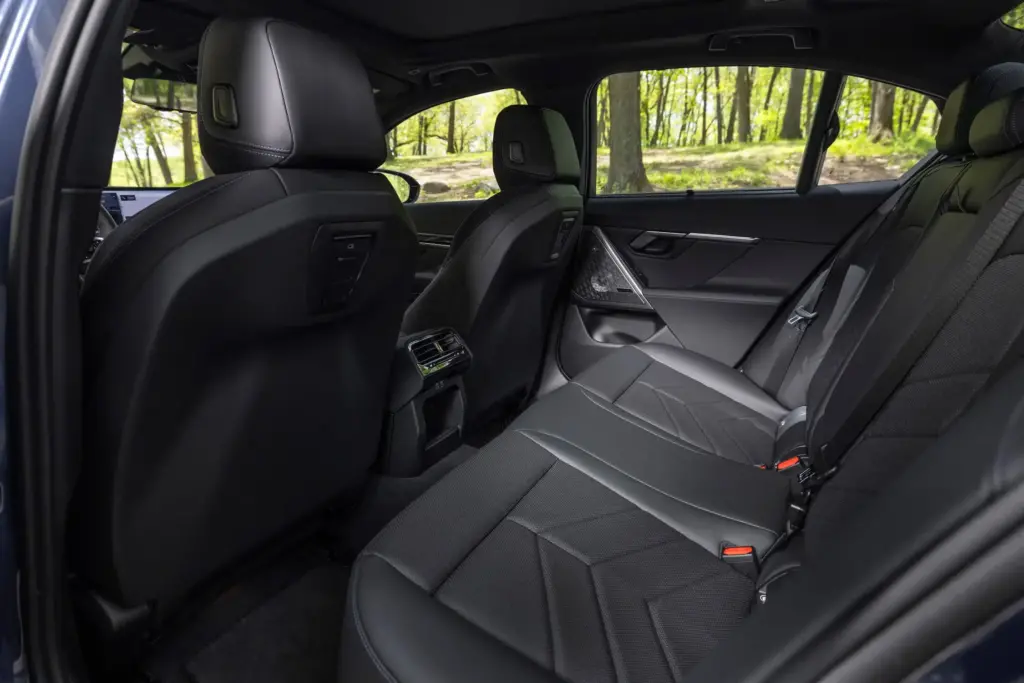
Competitive Comparison & Alternatives
BMW i5 vs Mercedes-Benz EQE
The Mercedes-Benz EQE starts at $77,900 with just 288 horsepower—$10,800 more than the i5 eDrive40’s $67,100 price for 335 horsepower. This pricing disadvantage represents Mercedes’ biggest challenge against the BMW[1].
| Specification | BMW i5 eDrive40 | Mercedes EQE 350+ | Advantage |
|---|---|---|---|
| Starting Price | $67,100 | $77,900 | BMW by $10,800 |
| Horsepower | 335 hp | 288 hp | BMW by 47 hp |
| EPA Range | 270-295 miles | 260 miles | BMW by 10-35 miles |
| Efficiency | 104/105 MPGe | 98/87 MPGe | BMW significantly better |
| Platform | Adapted gas chassis | Dedicated EV | Mercedes (flat floor) |
| Trunk Space | 490L | 430L | BMW by 60 liters |
The i5 offers better value and driving dynamics, while the EQE benefits from a dedicated EV platform providing a flat floor throughout the cabin. For most buyers, the i5’s superior performance, efficiency, and lower price make it the better choice[1].
BMW i5 vs Tesla Model S
The Tesla Model S Long Range starts at $76,380 with 670 horsepower and 405 miles of EPA range—substantially more than the i5’s 295 miles. Tesla’s Supercharger network provides faster, more convenient charging infrastructure throughout the United States[1].
| Specification | BMW i5 eDrive40 | Tesla Model S | Advantage |
|---|---|---|---|
| Starting Price | $67,100 | $76,380 | BMW by $9,280 |
| Horsepower | 335 hp | 670 hp | Tesla by 335 hp |
| EPA Range | 270-295 miles | 405 miles | Tesla by 110-135 miles |
| Efficiency | 104/105 MPGe | 127/116 MPGe | Tesla better |
| Cargo Space | 490L | 709L + 89L frunk | Tesla significantly more |
| Charging Network | Electrify America (CCS) | Supercharger | Tesla advantage |
Tesla offers more range, faster charging, and superior cargo capacity. However, the BMW provides traditional luxury sedan refinement with better interior materials, conventional controls, and BMW’s driving dynamics that many enthusiasts prefer over Tesla’s tech-forward minimalism[1].
For buyers prioritizing traditional automotive luxury with electric efficiency, the i5 represents the sweet spot. Tesla buyers prioritize technology, range, and the Supercharger network over conventional luxury appointments.
BMW i5 vs Porsche Taycan
The Porsche Taycan starts above $90,000, offering superior handling and sportiness thanks to its lower center of gravity and sport-focused suspension tuning. The Taycan’s 800V electrical architecture enables significantly faster charging—270 kW peak versus the i5’s 205 kW[1].
However, the i5 offers better everyday livability and practicality. The Taycan prioritizes performance over comfort, with a firmer ride and more aggressive seating position. For performance enthusiasts willing to pay premium prices, the Taycan delivers. For buyers seeking balanced luxury and usability, the i5 provides better value at a lower price point.
BMW i5 vs Genesis Electrified G80
The Genesis Electrified G80 offers a strong value proposition with similar luxury features at a potentially lower price than the i5. Genesis includes generous standard equipment and longer warranty coverage (10 years/100,000 miles on battery)[1].
The i5 counters with BMW brand prestige, more extensive dealer network coverage, and superior driving dynamics. Technology and feature parity exists between the models, making the choice primarily about brand preference, dealer accessibility, and budget considerations.
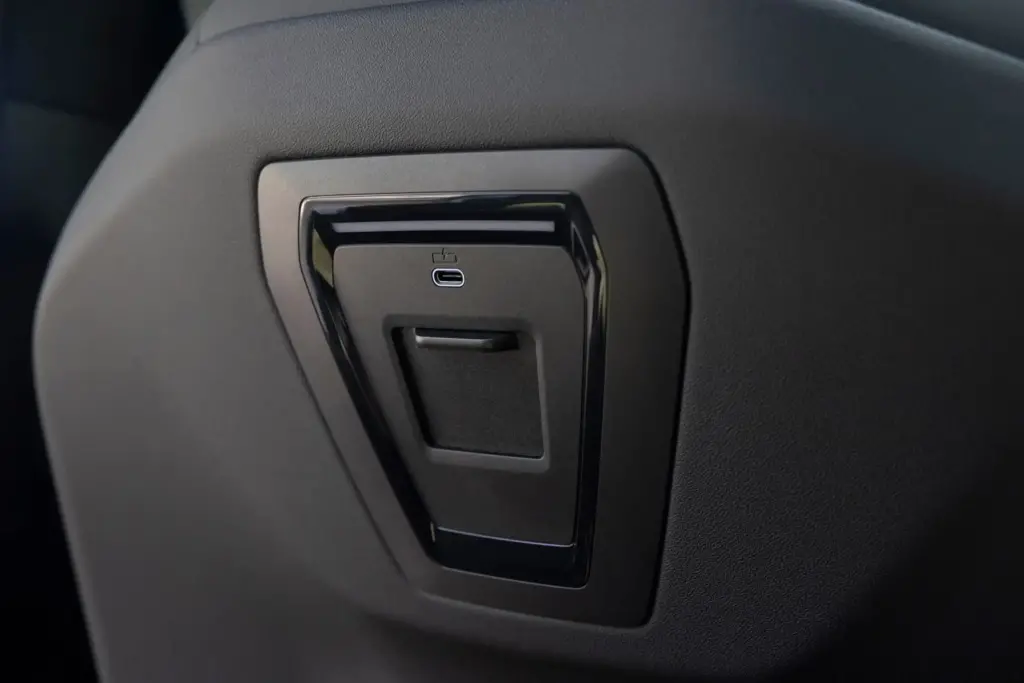
Pros & Cons Summary
Key Advantages
The 2025 BMW i5 excels in several critical areas that matter to American luxury sedan buyers[1][4]:
- Comfortable and classy cabin with premium materials throughout
- Abundant standard high-tech features including BMW Curved Display and iDrive 8.5
- Excellent real-world range that consistently exceeds EPA estimates (321 miles tested)
- Strong performance across all trims, especially the M60 model (3.3 seconds 0-60)
- Satisfyingly quick acceleration balanced with comfortable ride quality
- Quiet and smooth driving experience with minimal noise intrusion
- BMW driving dynamics maintained in electric format with precise handling
- Posh, luxurious interior with extensive soft-touch surfaces and quality fit/finish
- Great daily driver that feels faultless for commuting and long-distance travel
- Competitive pricing at $67,100 versus Mercedes EQE at $77,900
Notable Drawbacks
No vehicle is perfect, and the i5 has limitations worth considering[1][11]:
- Less driving range than key rivals: 295 miles EPA versus Tesla Model S 405 miles
- Infotainment tech borderline complicated: Main menu requires personalization
- Main menu layout can be overwhelming: Learning curve for new owners
- Less trunk space than gas 5 Series: 17-18 cubic feet versus larger sedans
- No frunk like Tesla or dedicated EV platforms
- High price point for luxury EV segment (though competitive with Mercedes)
- Some premium features missing from lower trims: Radar cruise control notably absent
- Heavy vehicle weight affects ultimate dynamics (4,900-5,200 lbs)
- Radar cruise control missing on base trims: Surprising omission
- Real-world range 240-250 miles for many xDrive40 owners: Less than eDrive40
- Slower charging than 800V competitors: 30 minutes vs 21 minutes (Audi A6 e-tron)
- Large central transmission tunnel: Compromises middle rear seat comfort
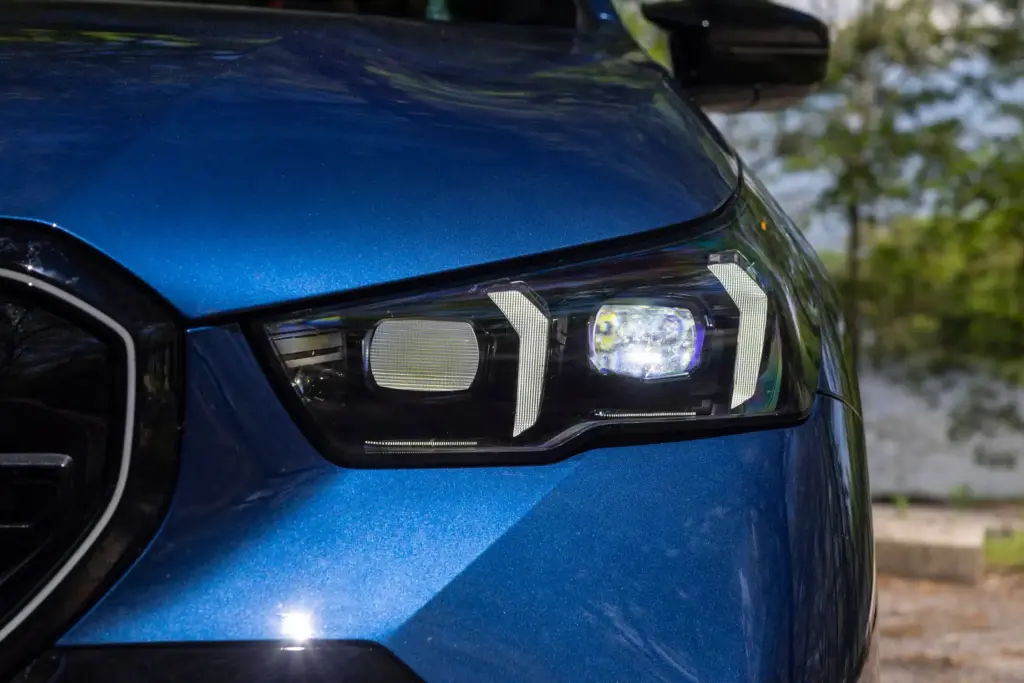
Final Verdict: Should You Buy the 2025 BMW i5?
Best For
The 2025 BMW i5 particularly suits several buyer profiles who value balanced capabilities over single standout specifications[1][4]:
- BMW enthusiasts making EV transition who want familiar driving dynamics
- Luxury sedan buyers wanting traditional refinement in electric package
- Daily commuters prioritizing comfort over maximum range figures
- Tech-savvy drivers with home charging who appreciate advanced features
- Buyers valuing driving dynamics over headline specifications
- Those seeking balanced performance and efficiency in premium sedan
Consider Alternatives If
Certain buyer priorities point toward competitors offering different strengths:
- Maximum range is top priority: Choose Tesla Model S (405 miles EPA)
- Budget-conscious EV shopping: Consider Genesis Electrified G80 (lower price, longer warranty)
- Need maximum cargo space: Choose SUV alternative or Tesla Model S (frunk + trunk)
- Want fastest charging speeds: Explore 800V competitors like Porsche Taycan or Audi A6 e-tron
- Seeking most affordable luxury EV: Multiple alternatives offer lower entry prices
Overall Rating & Recommendation
According to Autvex automotive experts and industry reviews, the 2025 BMW i5 earns strong marks across evaluation criteria[1][4]:
| Category | Rating | Commentary |
|---|---|---|
| Performance | 9/10 | Excellent acceleration across all trims; M60 delivers thrills |
| Interior | 9/10 | Premium materials, high-tech display; central tunnel compromises rear |
| Technology | 8/10 | Comprehensive features with learning curve for complexity |
| Comfort | 9/10 | Excellent ride quality and serene cabin |
| Value | 7.5/10 | Competitive pricing but lacks federal tax credit |
| Range | 7.5/10 | Good real-world performance but not class-leading |
| Overall Score | 8.4/10 | Strong buy for luxury EV sedan segment |
The 2025 BMW i5 represents a mature, well-executed electric luxury sedan that earned Editors’ Choice recognition for its balanced approach. It doesn’t chase headline numbers like 500-mile range or sub-3-second acceleration in base trims, instead focusing on delivering a well-rounded package that satisfies real-world needs[1].
For buyers seeking a premium electric sedan that drives like a BMW while offering excellent range and modern technology, the 2025 i5 delivers convincingly. The lack of federal tax credit eligibility after September 30, 2025, affects all new EVs equally, eliminating this as a differentiating factor for cross-shoppers.
Anyone considering the i5 should test drive it alongside the Mercedes EQE and Tesla Model S to experience the differences firsthand. The BMW’s driving dynamics, interior quality, and real-world range typically win over cross-shoppers who value traditional luxury sedan attributes over maximum specifications.
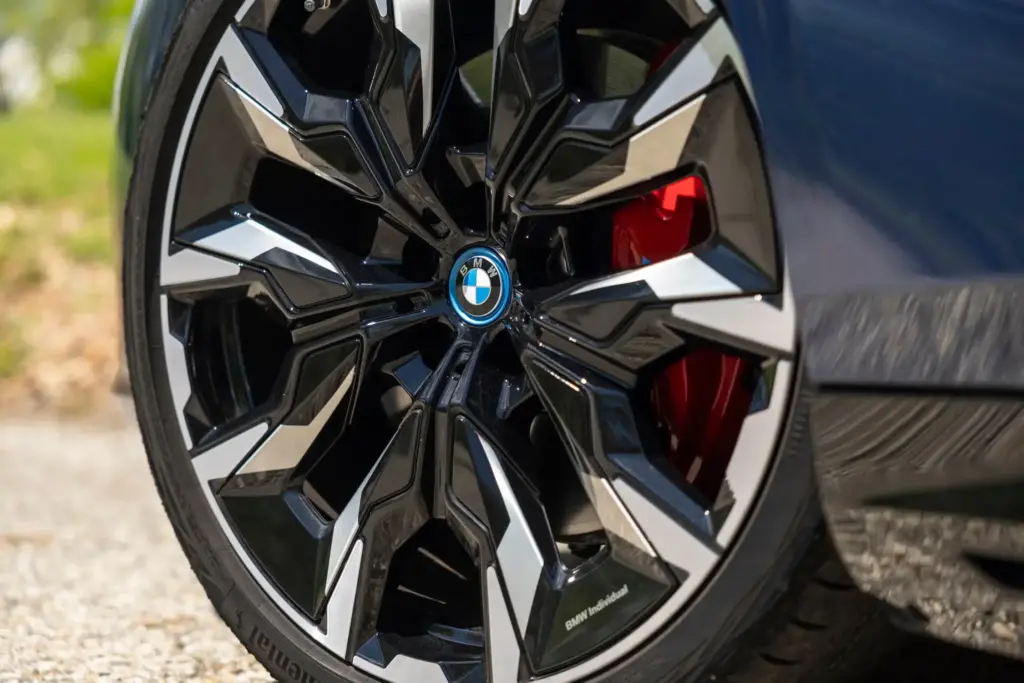
Key Takeaways
- The 2025 BMW i5 delivers 321 miles real-world range, exceeding EPA estimates by 19% in independent testing.
- Three trim levels from $67,100 to $84,100 offer 335-593 horsepower with balanced performance and comfort.
- Standard features include BMW Curved Display, Harman Kardon audio, and comprehensive driver assistance systems.
- Federal EV tax credits expire September 30, 2025, affecting all new EVs equally regardless of manufacturer.
- Real-world efficiency of 104/105 MPGe significantly outperforms Mercedes EQE and other luxury EV competitors.
- The i5 excels as a daily driver with faultless feel, quiet operation, and accurate range prediction.
- Buyers prioritizing traditional luxury sedan refinement over maximum range will find the i5 most satisfying.
FAQs
What is the range of the 2025 BMW i5?
The 2025 BMW i5 eDrive40 achieves 270-295 miles EPA estimated range depending on wheel size. Independent Edmunds testing achieved 321 miles on a single charge—19% better than EPA. The xDrive40 offers 248-287 miles, while the M60 provides 239-253 miles[2].
How much does the 2025 BMW i5 cost?
Pricing starts at $67,100 for the eDrive40, $70,100 for the xDrive40, and $84,100 for the M60. These prices remain unchanged from 2024 despite the addition of the xDrive40 trim. Options and destination charges add to base prices[1].
How long does it take to charge a BMW i5?
DC fast-charging from 10-80% takes approximately 30-32 minutes at 205 kW peak rates. Home Level 2 charging completes a full charge in under 9 hours at 7.4 kW. Ten minutes of DC fast-charging adds 90-100 miles of range[1].
Is the BMW i5 eligible for federal tax credit?
What’s the difference between i5 eDrive40 and xDrive40?
The eDrive40 uses a single 335-horsepower rear motor with rear-wheel drive and 270-295 miles range. The xDrive40 adds a front motor for 389 horsepower, all-wheel drive, 248-287 miles range, and costs $3,000 more at $70,100[1].
Does the BMW i5 have a frunk (front trunk)?
No, the 2025 BMW i5 does not have a front trunk. The space under the hood houses electronic components and the front motor on xDrive models. Cargo storage is limited to the 17-18 cubic foot rear trunk[1].
How does the BMW i5 compare to Tesla Model S?
The Tesla Model S offers more range (405 miles), faster charging via Supercharger network, and more cargo space (frunk + trunk). The BMW i5 provides superior interior quality, traditional luxury sedan refinement, and BMW driving dynamics at $67,100 versus Tesla’s $76,380[1].
Is the BMW i5 M60 worth the extra cost?
The M60’s $84,100 price ($17,000 premium over eDrive40) brings 593 horsepower, 3.3-second 0-60 mph times, adaptive M suspension, and Bowers & Wilkins audio. It’s worth it for performance enthusiasts but unnecessary for most buyers who’ll find the eDrive40 satisfying[6].
What are common problems with the BMW i5?
Owner reports cite battery and charging inconsistencies, software glitches requiring updates, brake regeneration inconsistency, occasional suspension noise, ADAS system faults, and infotainment complexity requiring learning. Most issues are software-related and addressable through updates[11].
Is the BMW i5 good as a daily driver?
How much cargo space does the BMW i5 have?
The BMW i5 provides 17-18 cubic feet (490 liters) of trunk capacity—less than the gas 5 Series but more than the Mercedes EQE (430L). It lacks a front trunk unlike Tesla Model S, which offers 709L rear plus 89L front[1].
Does the BMW i5 come with free charging?
Yes, BMW includes two years of complimentary Electrify America DC fast-charging with 30-minute sessions at the nation’s most extensive CCS charging network. This benefit represents $1,500-$2,000 value for moderate users and eliminates charging costs during early ownership[1].
References
- Car and Driver. (2024). “2025 BMW i5 Review, Pricing, and Specs.” https://www.caranddriver.com/bmw/i5
- Edmunds. (2025). “2025 BMW i5 Prices, Reviews, and Pictures.” https://www.edmunds.com/bmw/i5/2025/
- Tom Bush BMW. (2025). “BMW EV Tax Credit Ends Sept 30, 2025.” https://www.tombushbmw.com/bmw-ev-tax-credit.aspx
- Car Magazine. (2025). “BMW i5 (2025) review: electric done right.” https://www.carmagazine.co.uk/car-reviews/bmw/i5-saloon/
- Reddit. (2025). “Real Life Range feedback please: r/BMWi5.” https://www.reddit.com/r/BMWi5/comments/1kv5aiv/real_life_range_feedback_please/
- Car and Driver. (2024). “2024 BMW i5 M60 Tested: The Fun Flagship.” https://www.caranddriver.com/reviews/a60791304/2024-bmw-i5-m60-xdrive-test/
- BMW Blog. (2024). “BMW i5 M60 Overachieves In Range Test.” https://www.bmwblog.com/2024/04/23/bmw-i5-m60-overachieves-range-test/
- Bimmer Life. (2025). “2026 BMW EVs Have Discounts…For Now.” https://bimmerlife.com/2025/08/12/2026-bmw-evs-have-discounts-for-now/
- Business Car. (2024). “Final report: BMW i5 long-term test.” https://www.businesscar.co.uk/test-drives/latest-report-bmw-i5-long-term-test/
- IIHS. (2024). “2025 BMW i5 Safety Ratings.” https://www.iihs.org/ratings/vehicle/bmw/i5-4-door-sedan/2025
- MyCarly. (2025). “TOP 10 common BMW i5 Problems.” https://www.mycarly.com/community/brands/bmw/i5/
- Reddit. (2024). “Reasons the i5 is not loved around here?: r/BMW.” https://www.reddit.com/r/BMW/comments/1b1iwg0/reasons_the_i5_is_not_loved_around_here/

I am a senior automotive analyst at Autvex. Expert vehicle evaluations, in-depth reviews, and objective analysis helping readers make informed automotive decisions with years of industry experience.

